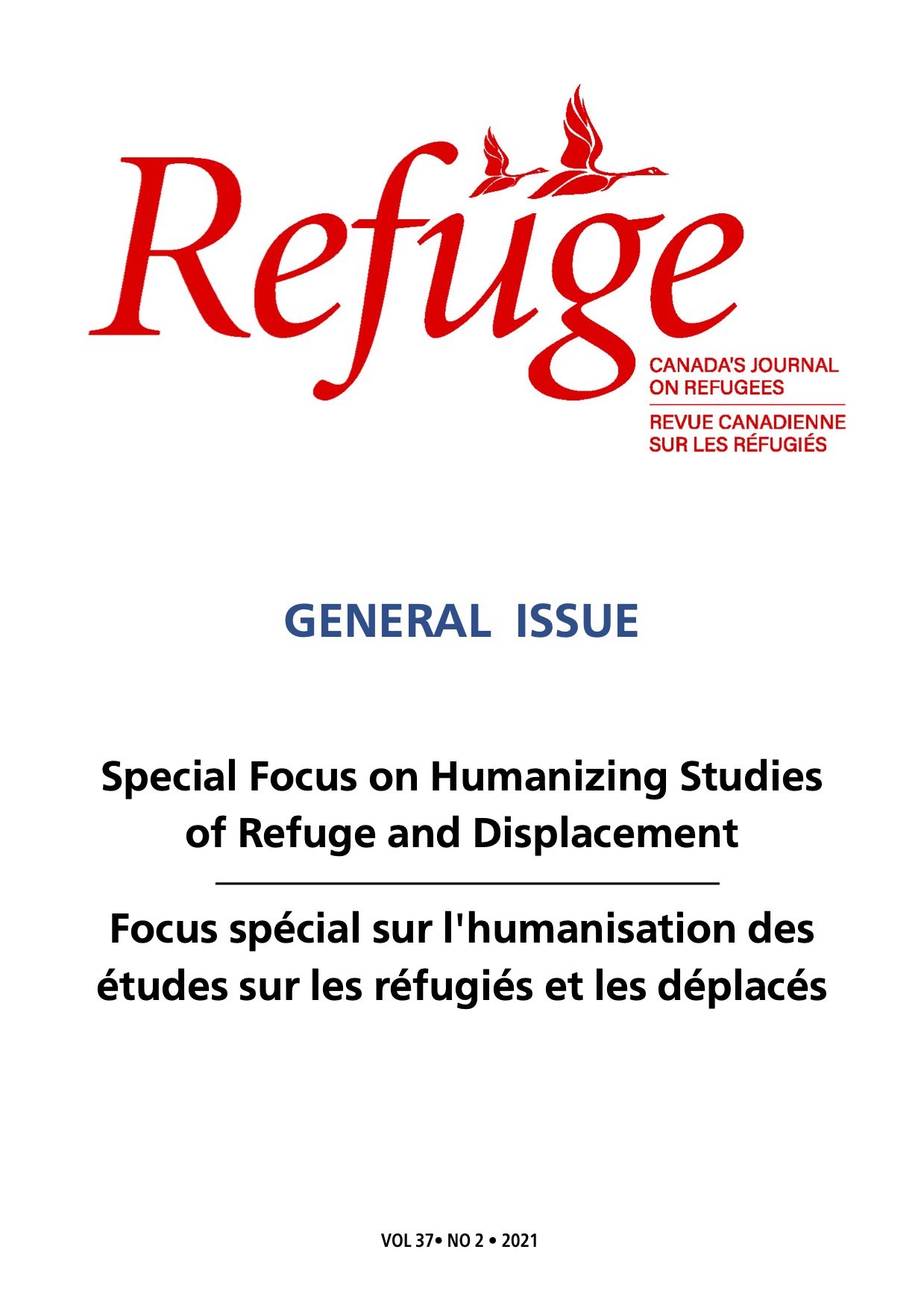The Cautious Politics of “Humanizing” Refugee Research
DOI :
https://doi.org/10.25071/1920-7336.40798Mots-clés :
humanization, refugee studies, refugee mobility, raceRésumé
Dans cette intervention, je réfléchis à ce que pourrait signifier d’ la recherche sur les réfugiés. On suppose souvent que l’humanisation» peutémerger à travers une attention à la particularité de l’individu, en puisant dans la le récit singulier et en utilisant ceci comme moyen de s’identifier, de compatir et potentiellement de comprendre les autres. Cependant, par un tel geste on court le risque de miser sur le recours à la création de relations d’empathie et de compassion qui passe outre à une réponse politique à la déshumanisation et qui repose sur une présomption universaliste de ce qui constitue la catégorie de l’, présomption qui a été remise en question par les écrits postcoloniaux.
Statistiques
Références
Arendt, H. (1958). The origins of totalitarianism. Meridian.
Bleiker, R., Campbell, D., Hutchison, E., & Nicholson, X. (2013). The visual dehumanisation of refugees. Australian Journal of Political Science, 48(4), 398–416. https://doi.org/10.1080/10361146.2013.840769 DOI: https://doi.org/10.1080/10361146.2013.840769
Burrell, K., & Hörschelmann, K. (2019). Perilous journeys: Visualising the racialised “refugee crisis.” Antipode, 51(1), 45–65. https://doi.org/10.1111/anti.12429 DOI: https://doi.org/10.1111/anti.12429
Collyer, M., & King, R. (2016). Narrating Europe’s migration and refugee “crisis.” Human Geography, 9(2), 1–12. https://doi.org/10.1177/194277861600900201 DOI: https://doi.org/10.1177/194277861600900201
Crawley, H. (2016). Managing the unmanageable? Understanding Europe’s response to the migration “crisis.” Human Geography, 9(2), 13–23. https://doi.org/10.1177/194277861600900202 DOI: https://doi.org/10.1177/194277861600900202
Crawley, H., & Skleparis, D. (2018). Refugees, migrants, neither, both: Categorical fetishism and the politics of bounding in Europe’s “migration crisis.” Journal of Ethnic and Migration Studies, 44(1), 48–64. https://doi.org/10.1080/1369183X.2017.1348224 DOI: https://doi.org/10.1080/1369183X.2017.1348224
Darling, J. (2014). From hospitality to presence. Peace Review, 26(2), 162–169. https://doi.org/10.1080/10402659.2014.906872 DOI: https://doi.org/10.1080/10402659.2014.906872
Darling, J. (2018). The fragility of welcome. Fennia, 196(2), 220–224. https://doi.org/10.11143/fennia.75756 DOI: https://doi.org/10.11143/fennia.75756
Dempsey, K. E., & McDowell, S. (2019). Disaster depictions and geopolitical representations in Europe’s migration “crisis.” Geoforum, 98(1), 153–160. https://doi.org/10.1177/194277861600900202 DOI: https://doi.org/10.1016/j.geoforum.2018.11.008
El-Enany, N. (2016). Aylan Kurdi: The human refugee. Law Critique, 27(1), 13–15. https://doi.org/10.1007/s10978-015-9175-7 DOI: https://doi.org/10.1007/s10978-015-9175-7
Esposito, R. (2012). Third person. Polity Press.
Forgiarini, M., Gallucci, M., & Malavita, A. (2011). Racism and the empathy for pain on our skin. Frontiers in Psychology, 2, Article 108. https://doi.org/10.3389/fpsyg.2011.00108 DOI: https://doi.org/10.3389/fpsyg.2011.00108
George, R. (2018, May 23). Exile or refuge? Lights in the Distance overturns the spurious distinction. New Statesman. https://www.newstatesman.com/2018/05/daniel-trilling-lights-dark-exile-refuge-borders-europe-review
Gill, N. (2016). Nothing personal? Geographies of governing and activism in the British asylum system. Wiley-Blackwell. DOI: https://doi.org/10.1002/9781118315996
Gill, N. (2018). The suppression of welcome. Fennia, 196(1), 88–98. https://doi.org/10.11143/fennia.70040 DOI: https://doi.org/10.11143/fennia.70040
Greussing, E., & Boomgaarden, H. G. (2017). Shifting the refugee narrative? An automated frame analysis of Europe’s 2015 refugee crisis. Journal of Ethnic and Migration Studies, 43(11), 1749–1774. https://doi.org/10.1080/1369183X.2017.1282813 DOI: https://doi.org/10.1080/1369183X.2017.1282813
Hartley, L., & Fleay, C. (2017). “We are like animals”: Negotiating dehumanising experiences of asylum-seeker policies in the Australian community Refugee Survey Quarterly, 36(4), 45–63. https://doi.org/10.1093/rsq/hdx010 DOI: https://doi.org/10.1093/rsq/hdx010
Haslam, N. (2006). Dehumanization: An integrative review. Personality and Social Psychology Review, 10(3), 252–264. https://doi.org/10.1207/s15327957pspr1003_4 DOI: https://doi.org/10.1207/s15327957pspr1003_4
Haslam, N., & Loughnan, S. (2014). Dehumanization and infrahumanization. Annual Review of Psychology, 65, 399–423. https://doi.org/10.1146/annurev-psych-010213-115045 DOI: https://doi.org/10.1146/annurev-psych-010213-115045
Ibrahim, Y., & Howarth, A. (2015). Sounds of the jungle: Rehumanizing the migrant. JOMEC Journal, 7, 1–19. https://doi.org/10.18573/j.2015.10008 DOI: https://doi.org/10.18573/j.2015.10008
Jazeel, T. (2019). Singularity: A manifesto for incomparable geographies. Singapore Journal of Tropical Geography, 40(1), 5–21. https://doi.org/10.1111/sjtg.12265 DOI: https://doi.org/10.1111/sjtg.12265
Jones, R. (2016). Violent borders: Refugees and the right to move. Verso.
Kingsley, P. (2017). The new odyssey: The story of Europe’s refugee crisis. Faber & Faber.
Kirkwood, S. (2017). The humanisation of refugees: A discourse analysis of UK parliamentary debates on the European refugee “crisis.” Journal of Community and Applied Social Psychology, 27(2), 115–125. https://doi.org/10.1002/casp.2298 DOI: https://doi.org/10.1002/casp.2298
McDonald-Gibson, C. (2016). Cast away: Stories of survival from Europe’s refugee crisis. Portobello Books.
Migrant Voice. (2014). Migration and the media. https://www.migrantvoice.org/design2020/img/upload/1._Migration-and-the-Media-2014_.pdf
Nyers, P. (2006). Rethinking refugees: Beyond states of emergency. Routledge.
Papastergiadis, N. (2009). Wog zombie: The de- and re-humanisation of migrants, from mad dogs to cyborgs. Cultural Studies Review, 15(2), 147–178. https://doi.org/10.5130/csr.v15i2.2043 DOI: https://doi.org/10.5130/csr.v15i2.2043
Sales, R. (2002). The deserving and the undeserving? Refugees, asylum seekers and welfare in Britain. Critical Social Policy, 22(3), 456–478. https://doi.org/10.1177/026101830202200305 DOI: https://doi.org/10.1177/026101830202200305
Smith, D. (2016) Refugee stories: Seven personal journeys behind the headlines. Instant Apostle.
Smith, K., & Waite, L. (2019) New and enduring narratives of vulnerability: Rethinking stories about the figure of the refugee. Journal of Ethnic and Migration Studies, 45(13), 2289–2307. https://doi.org/10.1080/1369183X.2018.1496816 DOI: https://doi.org/10.1080/1369183X.2018.1496816
Trilling, D. (2018). Lights in the distance: Exile and refuge at the borders of Europe. Picador.
Weheliye, A G. (2014). Habeas viscus: Racializing assemblages, biopolitics, and black feminist theories of the human. Duke University Press. DOI: https://doi.org/10.1515/9780822376491
Wilson, H. F. (2014). The possibilities of tolerance: Intercultural dialogue in a multicultural Europe. Environment and Planning D: Society and Space, 32(5), 852–868. https://doi.org/10.1068/d13063p DOI: https://doi.org/10.1068/d13063p
Téléchargements
Publié-e
Versions
- 2021-11-22 (2)
- 2021-11-22 (1)
Comment citer
Numéro
Rubrique
Licence
© Jonathan Darling 2021

Cette œuvre est sous licence Creative Commons Attribution - Pas d'Utilisation Commerciale 4.0 International.
Les auteurs qui publient dans Refuge conservent le droit d’auteur associé à leur œuvre, et octroient au public une licence Creative Commons Attribution - Utilisation non commerciale 4.0 International. La licence permet l’utilisation, la reproduction et l’adaptation du matériel avec attribution par tous moyens et sous tous formats pour des fins non commerciales. Pour des informations générales sur les licences Creative Commons, visitez le site Creative Commons. Pour la licence CC BY-NC 4.0, consultez le résumé lisible par l'homme.







